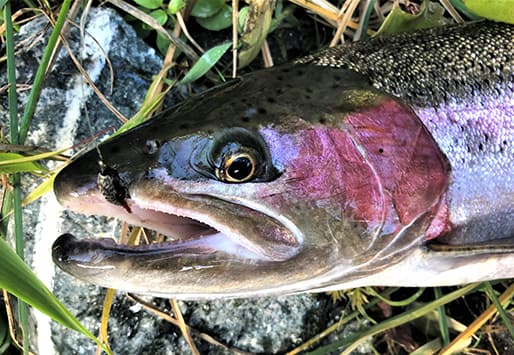Types of Steelhead
If you fish for the shrewd and tantalizing California steelhead, you may have heard them called either summer or winter steelhead. But what does that mean and is it easy to tell them apart? In this blog post, I explain the difference between these two ecotypes. These are groups of fish that have adapted because of different environmental conditions.
Winter steelhead are fish that mature in the ocean and enter freshwater ready to spawn. They usually arrive in late November through April, depending on the river system. Consequently not spending much time in freshwater before finding a suitable place to lay their eggs and fertilize them.
Summer steelhead are fish that enter freshwater immature and need more time to mature before they spawn. Therefore, usually arriving between May and October, again depending on the river system. They can spend several months in freshwater, sometimes even overwintering, before spawning.
Looking Different
Rainbow trout that migrate to the ocean off the coast of California are called steelhead. They feed and look similar in the ocean, but differ in timing and appearance when entering freshwater. Winter steelhead quickly develop darker body colors and other sexual traits. Summer steelhead also change color and show sexual traits, but they do it more gradually. In addition, exhibiting more rainbow trout-like colors because of spending more time in freshwater.
Why different strategies?
Well, it depends on the availability of food and habitat in the ocean and freshwater. Winter steelhead may benefit from staying longer in the ocean where they can feed and grow more. Summer steelhead may benefit from entering freshwater during higher streamflows. Above all migrating further upstream in the river to better spawning and juvenile fish habitats.
American River Steelhead
The American River near the city of Sacramento, California is a popular place for anglers fishing for winter steelhead. Unfortunately, Chinook salmon and steelhead runs were blocked by construction of Folsom and Nimbus dams in the early 1950’s. The Nimbus Salmon and Steelhead Hatchery was constructed as compensation for the loss and began operation in 1955. However, during the first years of operation, hatchery personnel trapped only a few hundred adult steelhead each season. The low number of steelhead prompted managers to transfer steelhead eggs from egg taking facilities on the Eel River, a coastal river with a large run of winter steelhead. Since then and in spite of introductions of steelhead from other rivers, American River winter steelhead continue to genetically most closely resemble Eel River steelhead.
What are Bluebacks?
A few anglers call steelhead that enter late in the winter “Bluebacks.” Leo Shapovalov and Alan C. Taft, California Department of Fish and Game Fishery Biologists, studied steelhead in Waddell Creek, a small coastal stream south of San Francisco. The results of their studies were reported in 1954 as California Department of Fish and Game, Fish Bulletin No. 94 – The Life Histories of the Steelhead Rainbow Trout (Salmo gairdneri gairdneri) and Silver Salmon (Oncorhynchus kisutch) With Special Reference to Waddell Creek, California, and Recommendations Regarding Their Management.
The two biologists noted changes in the life history composition of adult winter steelhead. They indicated – “Sportsmen and others have noted the variations in the composition of the steelhead run in streams which have not been investigated from a biological viewpoint. They speak of the occurrence of small fish in the early part of the run, followed by the ‘large winter steelhead,” in turn followed by fish of medium size, often known as ‘bluebacks’.” It was noted the later entering blueback steelhead were fish which had spent two or three years in freshwater, but only one season in the ocean. In addition, some were repeat spawners.
For More Information
My book, California Winter Steelhead – Life History and Fly Fishing, is a comprehensive guide for anyone who wants to learn more about these shrewd and tantalizing California steelhead and how to catch them. The book covers the biology and evolution of winter steelhead, as well as the history and status of their rivers. You will also discover fly fishing traditions, fishing techniques and equipment, and flies for winter steelhead. In conclusion, it is a valuable resource for anyone who enjoys winter steelhead fishing in California.
Connect to these other blogs:
A fly for a gigantic Christmas steelhead
Early California winter steelhead flies – some unique information
Why it’s a challenge catching an American River winter steelhead
Introducing the miracle of smoltification of anadromous salmonids
Number of exclusive facts about amazing american river spring steelhead
